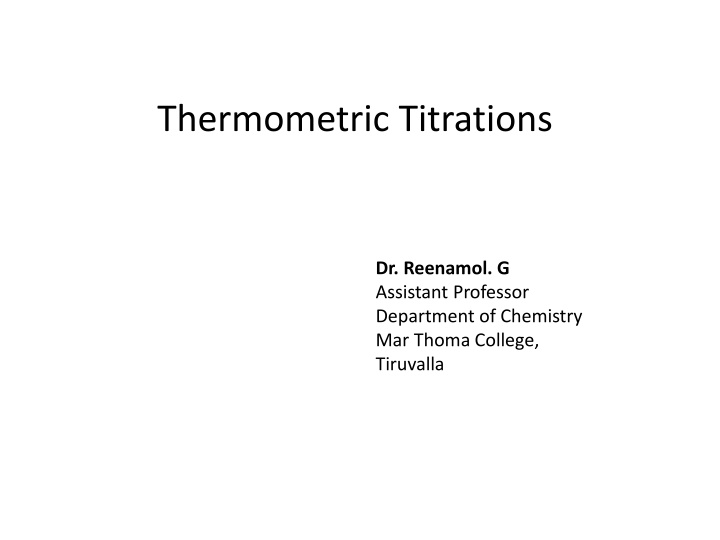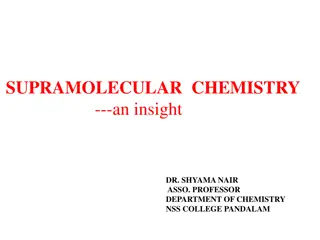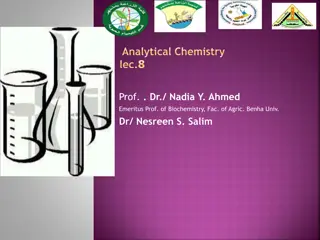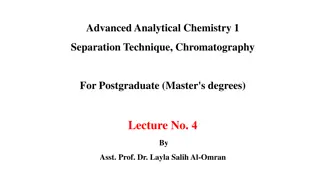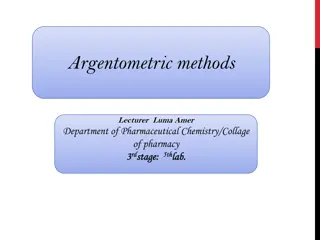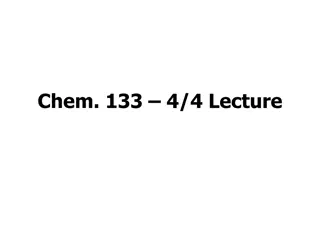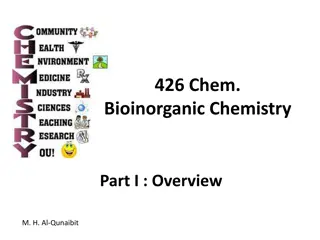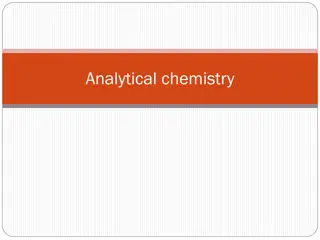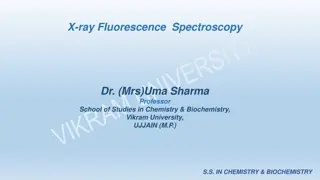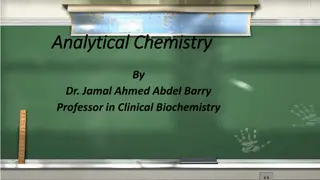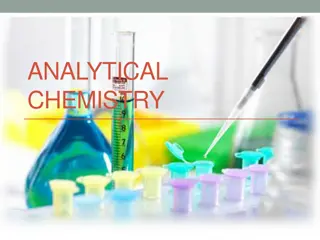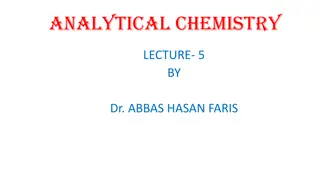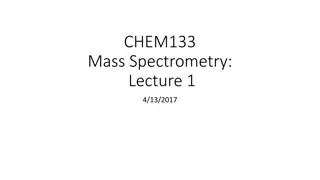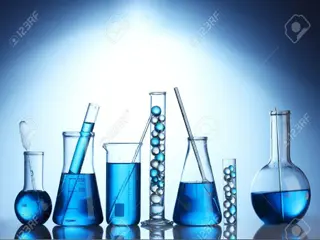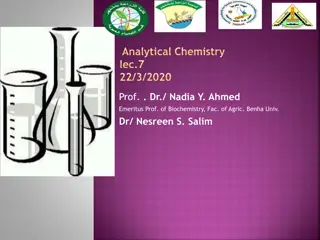Thermometric Titrations in Analytical Chemistry
Thermometric titrations, a method in analytical chemistry, involve continuous addition of a titrant to a reactant in an adiabatic vessel. The change in temperature due to the enthalpy change can be used to determine the titration endpoint. Redox reactions, being strongly exothermic, are ideal for this method. Examples include the determination of ferrous ion with permanganate and chloride with silver nitrate. Radiochemical methods like activation analysis and isotopic dilution are also discussed.
Uploaded on Mar 03, 2025 | 0 Views
Download Presentation

Please find below an Image/Link to download the presentation.
The content on the website is provided AS IS for your information and personal use only. It may not be sold, licensed, or shared on other websites without obtaining consent from the author.If you encounter any issues during the download, it is possible that the publisher has removed the file from their server.
You are allowed to download the files provided on this website for personal or commercial use, subject to the condition that they are used lawfully. All files are the property of their respective owners.
The content on the website is provided AS IS for your information and personal use only. It may not be sold, licensed, or shared on other websites without obtaining consent from the author.
E N D
Presentation Transcript
Thermometric Titrations Dr. Reenamol. G Assistant Professor Department of Chemistry Mar Thoma College, Tiruvalla
Thermometric Titrations An analytical method in which one reactant (the titrant) is added continuously or stepwise to an adiabatic vessel containing another reactant. Titrant is added at a known constant rate to a titrand until the completion of the reaction is indicated by a change in temperature. The enthalpy change(s) of the ensuing reaction(s) causes a temperature change which, when plotted versus volume of titrant, may be used to find the titration endpoint(s).
The temp change is due to the heat evolved or absorbed between the analyte and reagent The enthalpy H = G+ T S Temperature change during the titration is given by T= n H/K, where n is the number of moles of reactant and K is the heat capacity of the system. So, total change in temp is directly proportional to number of moles of the analyte
Redox reactions are normally strongly exothermic, and can make excellent candidates for thermometric titrations. In the classical determination of ferrous ion with permanganate, the reaction enthalpy is more than double that of a strong acid/strong base titration
2. The reaction of silver nitrate with chloride is strongly exothermic. For instance, the reaction enthalpy of Ag+with Cl is a high 61.2 kJ/mol. This permits convenient determination of chloride with commonly available standard 0.1 mol/L AgNO3.
Radiochemical methods 1. Activation analysis - Radioactivity is induced by irradiation 2. Physically introduce in to the sample ( eg, tracers)- A common method is Isotopic dilution method 3. Measure naturally occurring Radio activity Radio active decay Occurs with the emission of electromagnetic radiations They are four type: Alpha Beta Gamma X-rays
Alpha Radiation Alpha particles contain two protons and two neutrons ( Helium nucleus)
Alpha Radiation has the same constitution as a helium nucleus Alpha particles may be written as They have a double positive charge and a mass of 4 u
Beta- decay Encountered with negatron, positron and electron capture Beta-minus particles are electrons
Beta-minus Radiation - is produced when a neutron decays Beta-minus particles may be written as They have a negative charge and a mass of 1/1800 u
Beta-minus Radiation - is produced when a neutron decays The surplus mass is released as kinetic energy in the - and as an antineutrino
Beta-plus Radiation + particles (positron) are positrons
Beta-plus Radiation + is produced when a proton decays The surplus mass is released as kinetic energy in the + and as a neutrino Beta particles are not effective as alpha particles in producing ion pairs because of their small mass. Beta emission is characterised by production of particles with continuous spectrum.
Gamma Radiation Gamma rays are a form of electro- magnetic radiation
Gamma Radiation release is often associated with or decay Gamma rays remove energy from an unstable nucleus It is a nuclear relaxation process
X-ray Emission X rays are formed from Electronic transitions in which outer electrons fills the vacancies of inner shell electrons Internal conversion electromagnetic interaction btwn an excited nucleus and an extra nuclear electron results in the ejection of electron with a KE, which creates a vacancy and this vacancy is filled by X-ray emission It is an Electronic relaxation process
Penetrating power has a high mass It is stopped by a few centimetres of air has a small mass It is stopped by a few millimetres of aluminium has zero mass It is stopped by thick lead or concrete
Penetrating power has a high charge It is dangerous if swallowed has a small charge It is dangerous at medium range has high energy It is dangerous at distance
Decay laws - alpha When an isotope emits an particle Its nucleon number decreases by 4 Its proton number decreases by 2 For example:
Decay laws beta-minus When an isotope emits a - particle Its nucleon number is unchanged Its proton number increases by 1 For example:
Decay laws beta-plus When an isotope emits a + particle Its nucleon number is unchanged Its proton number decreases by 1 For example:
Decay laws Try writing the nuclear equations for the decay of these isotopes
Decay laws Answers
Radio active decay -dN/dt= N, first order rate N = number of radio active nuclei at time t = decay constant On integration with a range of t=0 to t and N=N0 to N, lnN/N0=- t N=Noe- t half its activity. Mathematically it is given by: Half life :: It is time taken for the radioactive substance to reduce to t1/2 = ln 2/Decay Constant
N v Z graphs A Graph of neutron number (N) against proton number (Z) helps to predict whether an isotope will emit or - radiation
Measurement of alpha, beta and Gamma radiations Instrumentation includes Gas filled chambers Scintillation counters, Semiconductor detector Pulse height analysers record the alpha particle spectra Pulse height analysers- Consists of one or more pulse height selectors configured to get the spectra A single channel analyser with a window of voltage 0.1 to 0.5 V The signal from channel is accumulated in the memory location of analyser permits the recording of spectra Measurement of Alpha: Thin film deposits of apha emitting samples were prepared by electrodeposition or vapourisation These deposits were counted in wondow-less ionization chamber Immediately placed adjacent to a solid state detector
Measurement of beta particles For low energy beta emitters like C-14, Sulpher-35, and tritium, liquid scintillation counters are used Sample is dissolved in to a soln of scintillation compound Vial containing sample is placed between the photomultiplier Output from the tube is collected in to the detector which records the counts Liquid scintillation helps to use this in clinical laboratories
Measurement of Gamma rays Gamma rays can be detected and measured in essentially the same way as X-radiation. Gas-filled transducers (Geiger tube)- Radiation enters the inert gas filled chamber and interact with the argon to produce photoelectrons. These PE produce a flood of electrons and cations which results in the current and is easy to measure Scintillation counters Consists of transparent crystal of Sodium iodide. As the radiation pass through the crystal, it lost its energy, released as photons of fluorescence. This light is transmitted to the photocathod tube and converted to electrical pulses which can be amplified and counted Number of photons produced in each flash is equal to the energy of radiation Semiconductor detectors - consists of Li drifted Si or Ge, fashioned as three layers of P-type --- central intrinsic zone---- n-type layer. When a voltage is applied across the crystal, a current pulse accompanies the absorption of photons and the size of pulse directly proportional to the energy of the photon. The photons pre amplified and detected.
Gamma Ray Spectrometer Gamma ray Multichannel pulse- height analyzer + Q e e e h h eh Voltage supply Germanium crystal counts display
What is Neutron Activation Analysis (NAA)? NAA is a method for qualitative and quantitative determination of elements based on the measurement of characteristic radiation from radionuclides formed directly or indirectly by neutron irradiation of the material. Detect the concentration of elements in a sample
NAA Method For Example, Irradiate sodium (Na23) sample with neutrons Neutron captured to give Na24 in excited state Jumps to lowest state of Na24 > emits gamma-ray(s) (photon) With 1/2 life 15 hours: Na24 emits electron to become Mg24 (beta decay) And another gamma (photon)
NAA Categories According to type of emitted -ray measured If the Prompt -ray is the measured radiation Prompt -ray neutron activation analysis (PGNAA) The measurements take place during irradiation. If Delayed -ray is the measured radiation. Delayed -ray neutron activation analysis (DGNAA) The measurements take place after a certain decay period. (DGNAA) is more common.
I. PGNAA The PGNAA technique is generally performed by using a beam of neutrons extracted through a reactor beam port. Detectors are placed very close to the sample compensating for much of the loss in sensitivity due to flux. The PGNAA technique is most applicable to elements with extremely high neutron capture cross-sections (B, Cd, Sm, and Gd); elements which decay too rapidly to be measured by DGNAA; elements that produce only stable isotopes; or elements with weak decay gamma-ray intensities.
II. DGNAA DGNAA (sometimes called conventional NAA) is useful for the vast majority of elements that produce radioactive nuclides. The technique is flexible with respect to time such that the sensitivity for a long-lived radionuclide that suffers from an interference by a shorter-lived radionuclide can be improved by waiting for the short-lived radionuclide to decay. This selectivity is a key advantage of DGNAA over other analytical methods.
Instrumental vs. Radiochemical NAA It is generally possible to simultaneously measure more than thirty elements in most sample types without chemical processing. The application of purely instrumental procedures is commonly called instrumental neutron activation analysis (INAA) and is one of NAA's most important advantages over other analytical techniques. If chemical separations are done to samples after irradiation to remove interferences or to concentrate the radioisotope of interest, the technique is called radiochemical neutron activation analysis (RNAA).
NAAprocedure Sampling; Pre-irradiation sample treatment (such as cleaning, drying or ashing, pre-concentration of elements of interest or elimination of interfering elements, sub- sampling and packing); Irradiation (and prompt gamma-ray counting in PGNAA); Radiochemical separation (only in RNAA); Radioactivity measurement; Elemental concentration calculation; Critical evaluation of results and preparation of the NAA report.
Irradiation There are several types of neutron sources: reactors, accelerators, and radioisotopic neutron emitters. Nuclear reactors with their high fluxes of neutrons offer the highest available sensitivities for most elements. Most neutron energy distributions are quite broad and consist of three principal components (thermal, epithermal, and fast).
I. Thermal Flux The thermal neutron component consists of low-energy neutrons (energies below 0.5 eV) in thermal equilibrium with atoms in the reactor's moderator. At room temperature, the energy spectrum of thermal neutrons is best described by a Maxwell-Boltzmann distribution with a mean energy of 0.025 eV and a most probable velocity of 2200 m/s. In most reactor irradiation positions, 90-95% of the neutrons that bombard a sample are thermal neutrons.
II. Epithermal Flux The epithermal neutron component consists of neutrons (energies from 0.5 eV to about 0.5 MeV) A cadmium foil 1 mm thick absorbs all thermal neutrons but will allow epithermal and fast neutrons above 0.5 eV In a typical unshielded reactor irradiation position, the epithermal neutron flux represents about 2% the total neutron flux. Both thermal and epithermal neutrons induce (n,gamma) reactions on target nuclei. An NAA technique that employs only epithermal neutrons to induce (n,gamma) reactions by irradiating the samples inside either cadmium or boron shields is called epithermal neutron activation analysis.
III. Fast Flux The fast neutron component of the neutron spectrum (energies above 0.5 MeV) consists of the primary fission neutrons which still have much of their original energy following fission. Fast neutrons contribute very little to the (n,gamma) reaction, but instead induce nuclear reactions where the ejection of one or more nuclear particles - (n,p), (n, ), and (n,2n) - are prevalent. In a typical reactor irradiation position, about 5% of the total flux consists of fast neutrons. An NAA technique that employs nuclear reactions induced by fast neutrons is called fast neutron activation analysis (FNAA).
Advantages of NAA Very low detection limits for 30 40 elements, Simultaneous analysis for many elements Chemical preparation rarely necessary Non-destructive testing Reliable quantitative results Very high sensitivity (for some elements)In the field of coal, metals, sediments, ores, tissues, bone, synthetic fibers, alloys, bullets, crystals, gems, glass, hair, gunshot residues, moon samples, wheat spores, wood, tree leaves, tree needles, plastic films, rocks, salts, shells, skin, soil, sugar, teeth, minerals, metals. NAA can be used to determine the presence of a variety of elements in a sample. Examples include: Mercury levels in tuna fish Aluminum levels in finger nails Gold levels in hair Zinc levels in soil Arsenic levels in plants
Isotope Dilution Analysis In this method, a weighed quantity of tagged analyte having a known activity is added to a measured amount of sample. radioactively The mixture is then mixed to homogeneity and then a fraction of the compound of interest is purified. The analysis is based upon the activity of the isolated fraction. isolated and
